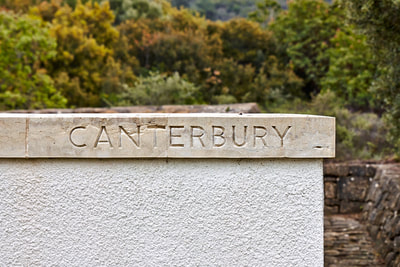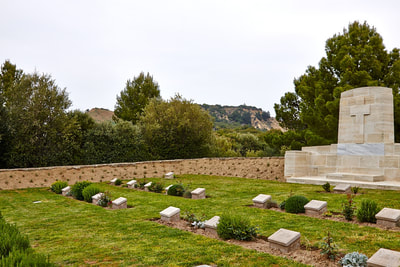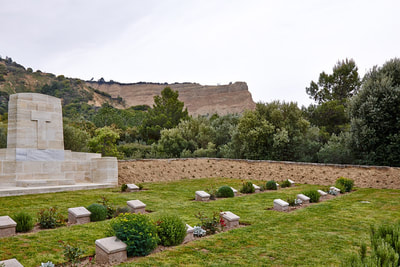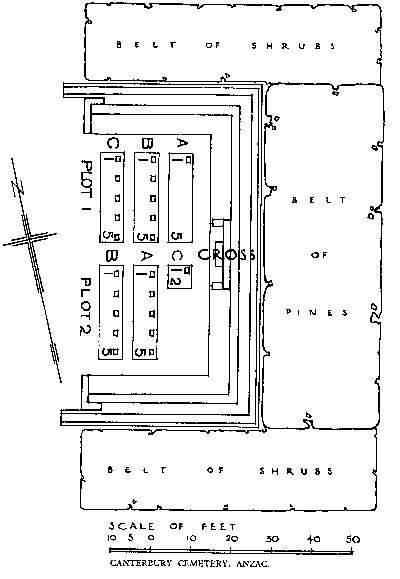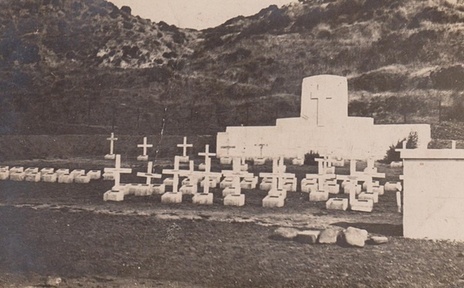CANTERBURY CEMETERY (ANZAC)
Gallipoli
Turkey
Location Information
The Anzac and Suvla cemeteries are first signposted from the left hand junction of the Eceabat- Bigali road. From this junction travel into the main Anzac area.
After 11.6kms Canterbury cemetery will be found on your right.
Visiting Information
The Cemetery is permanently open and may be visited at any time.
Historical Information
The eight month campaign in Gallipoli was fought by Commonwealth and French forces in an attempt to force Turkey out of the war, to relieve the deadlock of the Western Front in France and Belgium, and to open a supply route to Russia through the Dardanelles and the Black Sea.
The Allies landed on the peninsula on 25-26 April 1915; the 29th Division at Cape Helles in the south and the Australian and New Zealand Corps north of Gaba Tepe on the west coast, an area soon known as Anzac.
Canterbury Cemetery is one of the central cemeteries in Anzac and was made after the Armistice. It contains the graves of 27 Commonwealth Servicemen of the First World War, five of them unidentified. 20 of the graves are of men of the New Zealand Mounted Rifles (mostly the Canterbury Mounted Rifles).
Identified Casualties:
New Zealand 22
Cemetery pictures © Geerhard Joos
The Anzac and Suvla cemeteries are first signposted from the left hand junction of the Eceabat- Bigali road. From this junction travel into the main Anzac area.
After 11.6kms Canterbury cemetery will be found on your right.
Visiting Information
The Cemetery is permanently open and may be visited at any time.
Historical Information
The eight month campaign in Gallipoli was fought by Commonwealth and French forces in an attempt to force Turkey out of the war, to relieve the deadlock of the Western Front in France and Belgium, and to open a supply route to Russia through the Dardanelles and the Black Sea.
The Allies landed on the peninsula on 25-26 April 1915; the 29th Division at Cape Helles in the south and the Australian and New Zealand Corps north of Gaba Tepe on the west coast, an area soon known as Anzac.
Canterbury Cemetery is one of the central cemeteries in Anzac and was made after the Armistice. It contains the graves of 27 Commonwealth Servicemen of the First World War, five of them unidentified. 20 of the graves are of men of the New Zealand Mounted Rifles (mostly the Canterbury Mounted Rifles).
Identified Casualties:
New Zealand 22
Cemetery pictures © Geerhard Joos
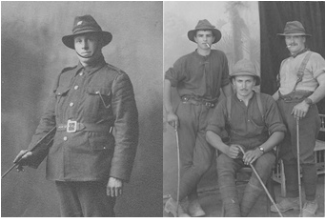
7/1373 Trooper
John Guthrie Brass Kirkness
Canterbury Mounted Rifles, N.Z.E.F.
10th December 1915, aged 29.
Plot II. B. 4.
Son of William Robert Brass Kirkness and Jane Guthrie Kirkness, of Midhouse, Kirkness, Sandwick, Orkney, Scotland.
The first photo was taken in Ashburton before John (who seemed to have been known as both Jack and Jock judging by the names on the back of the photos) left New Zealand. The second, which must have been taken sometime between Dec 1914 and April 1915, shows him (on the right) with two unnamed New Zealand mates at Cairo - they look like lads on an adventure. These photos would have been treasured photos at the time and still are now.
John was the third child (of five children) of William Robert Brass Kirkness and Jane Guthrie and was born on the 6 March 1886 at Queenamoan, Scabra, Sandwick, Orkney. His mother died on 9 May 1891 when he was five. His father remarried soon after her death and fathered seven more children. In the 1901 Scottish Census, at age 15, John was recorded as a farmer's son living with his father, stepmother, his younger sister and three of his half siblings at the above address. John, following his older brother and wife, emigrated to New Zealand via London on The Athenic departing London in June 1905. Before joining the Canterbury Mounted Rifles, he was recorded as living and working as a farmhand near Ashburton, Canterbury, New Zealand in 1911.
Pictures and text above courtesy of Virginia Rapson
John Guthrie Brass Kirkness
Canterbury Mounted Rifles, N.Z.E.F.
10th December 1915, aged 29.
Plot II. B. 4.
Son of William Robert Brass Kirkness and Jane Guthrie Kirkness, of Midhouse, Kirkness, Sandwick, Orkney, Scotland.
The first photo was taken in Ashburton before John (who seemed to have been known as both Jack and Jock judging by the names on the back of the photos) left New Zealand. The second, which must have been taken sometime between Dec 1914 and April 1915, shows him (on the right) with two unnamed New Zealand mates at Cairo - they look like lads on an adventure. These photos would have been treasured photos at the time and still are now.
John was the third child (of five children) of William Robert Brass Kirkness and Jane Guthrie and was born on the 6 March 1886 at Queenamoan, Scabra, Sandwick, Orkney. His mother died on 9 May 1891 when he was five. His father remarried soon after her death and fathered seven more children. In the 1901 Scottish Census, at age 15, John was recorded as a farmer's son living with his father, stepmother, his younger sister and three of his half siblings at the above address. John, following his older brother and wife, emigrated to New Zealand via London on The Athenic departing London in June 1905. Before joining the Canterbury Mounted Rifles, he was recorded as living and working as a farmhand near Ashburton, Canterbury, New Zealand in 1911.
Pictures and text above courtesy of Virginia Rapson

